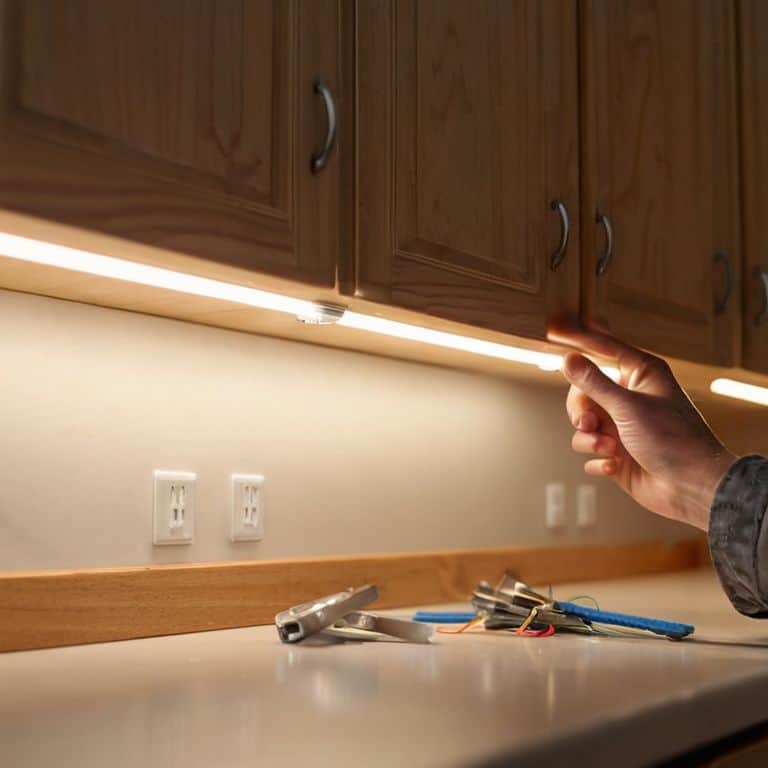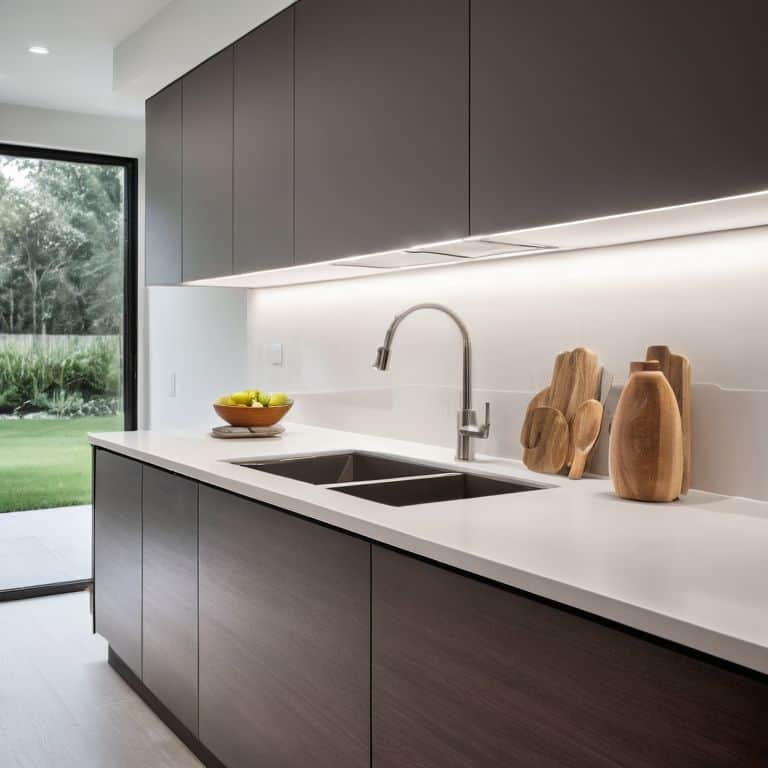I still remember the moment I realized the power of a guide to under-cabinet lighting in transforming a kitchen. I was working with a client who had a beautiful, yet poorly lit, cooking space. The lack of under-cabinet lighting made the countertops appear dull and uninviting. But after installing some sleek LED strips, the entire kitchen was revitalized. The countertops seemed to shine, and the cooking experience became more enjoyable. This experience taught me that under-cabinet lighting is not just about aesthetics; it’s about creating a functional and inspiring workspace.
In this article, I’ll share my expertise on a guide to under-cabinet lighting, providing you with practical tips and honest advice on how to choose and install the perfect lighting for your kitchen. You’ll learn how to assess your kitchen’s unique needs, select the right type of lighting, and implement a design that enhances your cooking experience. Whether you’re a seasoned chef or a culinary newbie, I’ll show you how to create a kitchen that’s both beautiful and functional, with under-cabinet lighting that elevates your cooking game. By the end of this guide, you’ll be equipped with the knowledge to transform your kitchen into a warm and inviting space that inspires you to cook with joy.
Table of Contents
Guide Overview: What You'll Need

Total Time: 2 hours 30 minutes
Estimated Cost: $50 – $100
Difficulty Level: Intermediate
Tools Required
- Drill (with screwdriver and drill bits)
- Pliers (for gripping and bending)
- Wire Strippers (for stripping electrical wires)
- Tape Measure (for measuring spaces)
- Level (for ensuring even installation)
- Screwdriver (for driving screws)
Supplies & Materials
- LED Light Strips (available in various lengths)
- Under-Cabinet Lighting Kits (including power adapter and switch)
- Electrical Wire (for connecting lights to power source)
- Wire Nuts or Connectors (for secure wire connections)
- Mounting Clips or Adhesives (for securing lights under cabinets)
- Power Strip or Outlet (for plugging in the lights)
Step-by-Step Instructions
- 1. To start, assess your kitchen’s layout and identify the areas that need the most lighting attention. Consider the position of your countertops, sink, and stove, as these will be the primary focal points for your under-cabinet lighting. Take note of any obstacles, such as plumbing or electrical outlets, that may affect the installation process.
- 2. Next, determine your lighting goals: are you looking to create a warm and inviting ambiance, or do you need task-oriented lighting to improve visibility while cooking? This will help you decide on the type and color temperature of the lighting you need. For example, warm white light (2700K-3000K) can create a cozy atmosphere, while cool white light (3500K-5000K) is better suited for task lighting.
- 3. Choose the right type of under-cabinet lighting for your needs. You can opt for LED strip lights, which are energy-efficient and easy to install, or go for more traditional options like puck lights or linear fixtures. Consider factors such as brightness, color temperature, and dimmability when making your selection.
- 4. Measure your cabinets and countertops to determine the correct length and placement of your under-cabinet lighting. Leave about 1-2 inches of space between the lighting and the edge of the countertop to create a seamless look. You can use a template or a piece of string to help you visualize the layout and mark the spot where you’ll be installing the lights.
- 5. Install your under-cabinet lighting, starting with the most visible areas first. If you’re using LED strip lights, peel off the backing and press the lights firmly onto the underside of the cabinet. Make sure they’re evenly spaced and aligned with the edge of the countertop. For other types of lighting, follow the manufacturer’s instructions for installation.
- 6. Connect your under-cabinet lighting to a power source, which can be a plug, a hardwired connection, or a battery-operated option. Consider installing a dimmer switch to adjust the brightness and ambiance of your lighting. This will give you more control over the mood and functionality of your kitchen.
- 7. Test your under-cabinet lighting to ensure it’s working properly and adjust the placement or brightness as needed. Pay attention to any hot spots or areas where the light may be too harsh, and make adjustments to achieve a smooth, even glow. Finally, step back and enjoy your newly illuminated kitchen, and don’t be afraid to experiment with different lighting scenarios to find the perfect balance of form and function.
A Guide to Under Cabinet Lighting

As I always say, good lighting is the backbone of a functional kitchen. When it comes to under cabinet lighting ideas, it’s essential to consider the type of lighting that suits your kitchen style. For instance, LED lighting for kitchen counters can provide a sleek and modern look, while also being energy efficient. I’ve seen many of my clients opt for this option, and it’s truly transformed their kitchen workflow.
When designing your cabinet lighting, it’s crucial to think about the dimming options for under cabinet lights. This feature can help you adjust the lighting to suit different tasks, from food preparation to cooking. I recommend exploring energy efficient under cabinet lighting solutions that not only save you money but also reduce your carbon footprint. By making a few simple adjustments, you can create a kitchen that’s not only beautiful but also functional.
To take your under-cabinet lighting to the next level, consider layering your lighting. This involves combining different light sources to create a unique ambiance in your kitchen. For example, you can pair under-counter lighting solutions with overhead lighting to create a warm and inviting atmosphere. By doing so, you’ll be able to enjoy your kitchen space even more, whether you’re cooking a meal or simply relaxing with family and friends.
Brightening Up Led Lighting for Kitchen Counters
When it comes to LED lighting for kitchen counters, I always get excited about the possibilities. Not only does it provide ample illumination for food prep, but it also adds a touch of sophistication to the space. I’ve seen it work wonders in even the smallest of kitchens, making countertops appear larger and more inviting. Plus, with the variety of LED strip lights available, you can easily find a style that complements your kitchen’s unique aesthetic.
For a sleek, modern look, consider installing LED lights with a warm white hue, which can create a cozy ambiance while still providing sufficient task lighting. This is especially useful for kitchens with limited natural light, as it can help make the space feel brighter and more welcoming.
Shine on Under Cabinet Lighting Ideas
When it comes to under-cabinet lighting, the possibilities are endless. I love experimenting with different styles and layouts to find the perfect fit for each kitchen. For a modern look, consider installing LED strip lights with a cool white tone to create a sleek, high-tech ambiance. Alternatively, warm white or soft glow lights can add a cozy, inviting feel to your kitchen. You can also play with placement, positioning lights to highlight specific design elements, such as a beautiful stone countertop or a decorative tile backsplash.
To take your under-cabinet lighting to the next level, think about layering different light sources. Combine strip lights with puck lights or under-cabinet fixtures to create a rich, multi-dimensional glow. This not only enhances the overall aesthetic but also provides ample task lighting for food preparation and cooking. By embracing under-cabinet lighting, you can transform your kitchen into a warm, welcoming space that inspires culinary creativity.
Illuminate Your Space: 5 Essential Tips for Under-Cabinet Lighting
- Illuminate the Task at Hand: Position under-cabinet lighting to shine directly on countertops where food preparation occurs, reducing shadows and making cooking safer and more efficient
- Layer Your Lighting: Combine under-cabinet lights with other lighting sources, like overhead fixtures and natural light, to create a layered lighting effect that adapts to different tasks and moods
- Choose the Right Color Temperature: Select LED lights with a color temperature that complements your kitchen’s style – warm white for traditional kitchens, cool white for modern spaces, and daylight for a bright, airy feel
- Consider the Beam Angle: Opt for under-cabinet lights with adjustable beam angles to direct light exactly where you need it, minimizing waste and ensuring that every inch of your countertop is well-lit
- Dimming is Key: Invest in under-cabinet lighting with dimming capabilities to adjust the light level according to your needs, from bright task lighting for food prep to soft ambiance for dinner parties
Key Takeaways for a Brighter Kitchen
Illuminating your kitchen counters with under-cabinet lighting can significantly improve visibility and workflow, making cooking easier and more enjoyable
Choosing the right type of under-cabinet lighting, such as LED strips or puck lights, depends on your kitchen’s specific layout, style, and the tasks you perform most frequently
By incorporating under-cabinet lighting into your kitchen design, you can create a warm and inviting atmosphere, highlight beautiful countertops, and make the space feel more spacious and functional
Illuminating Insights
When done right, under-cabinet lighting is more than just a design flourish – it’s a functional hug for your kitchen, making every meal prep a joy and every dinner party a dazzling success.
Clara Wu
Illuminating Your Culinary Space

As we’ve explored in this guide to under-cabinet lighting, the right illumination can make a significant difference in your kitchen’s functionality and ambiance. From enhancing task lighting to creating a warm and inviting atmosphere, under-cabinet lighting is a versatile design element that can elevate your cooking experience. We’ve discussed various options, including LED strip lights, and provided step-by-step instructions to help you get started. By considering factors like kitchen layout and personal style, you can choose the perfect under-cabinet lighting solution to suit your needs.
As you embark on this lighting journey, remember that it’s all about striking a balance between form and function. Don’t be afraid to experiment and find the perfect blend of aesthetics and practicality. With the right under-cabinet lighting, you’ll be inspired to cook, create, and make memories in your kitchen. So, go ahead and shine a light on your culinary space – your inner chef will thank you!
Frequently Asked Questions
What are the most energy-efficient options for under-cabinet lighting?
For an eco-friendly glow, I swear by LED tape lights or puck lights – they’re not only energy-efficient but also dimmable, letting you adjust the ambiance to suit your cooking style. Plus, they’re incredibly easy to install, making them a practical choice for any kitchen renovation.
How do I determine the best color temperature for my kitchen's under-cabinet lighting?
To determine the best color temperature for your kitchen’s under-cabinet lighting, consider the mood you want to create. Warm white (2700K-3000K) is cozy and perfect for traditional kitchens, while cool white (3500K-5000K) is crisp and ideal for modern spaces. Think about the time of day you’ll be cooking most and the type of lighting that will enhance your workflow.
Can under-cabinet lighting be installed as a DIY project or is professional installation recommended?
While it’s possible to DIY under-cabinet lighting, I recommend professional installation for a seamless look and optimal performance, especially if you’re not comfortable with electrical work. However, if you’re handy, many LED strip lights come with easy-to-follow instructions and adhesive backs for a straightforward installation process.
